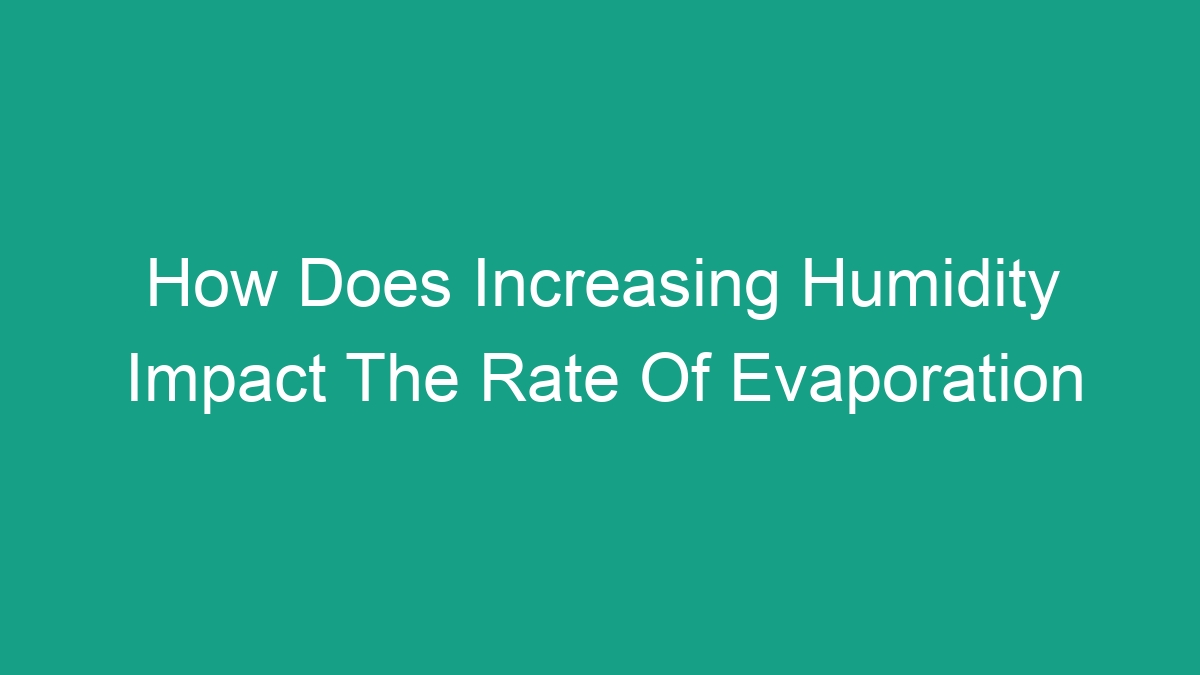
Evaporation is a crucial natural process that occurs when a liquid turns into a gas. It is a vital component of the water cycle and plays a significant role in the Earth’s climate. Many factors can influence the rate of evaporation, including temperature, surface area, and humidity. This article will delve into the impact of increasing humidity on the rate of evaporation. We will explore the science behind this phenomenon and its implications for various aspects of our environment.
The Science of Evaporation
Before we discuss the impact of humidity on evaporation, it is essential to understand the science behind this process. Evaporation occurs when the molecules of a liquid gain enough energy to transition into the gaseous phase. This energy typically comes from heat, which is why evaporation rates tend to increase with higher temperatures. As the liquid molecules escape into the air, they create a vapor pressure above the liquid’s surface. This vapor pressure is crucial in determining the rate of evaporation, as it indicates the force exerted by the evaporating molecules.
Impact of Humidity on Evaporation
Humidity refers to the amount of water vapor present in the air. When the humidity is high, the air is already saturated with water vapor, making it more difficult for additional molecules to evaporate from a liquid surface. This is because the vapor pressure above the liquid must surpass the ambient vapor pressure in the air for evaporation to occur. Therefore, increasing humidity slows down the rate of evaporation.
Furthermore, high humidity levels can also lead to the condensation of water vapor back into liquid form. When the air is nearly saturated with moisture, the likelihood of condensation increases. This means that the water molecules in the air are more likely to return to the liquid state instead of staying in the gaseous phase. As a result, the overall rate of evaporation is further diminished in humid conditions.
Factors Affecting Evaporation
Temperature: As mentioned earlier, higher temperatures generally result in faster evaporation rates. This is because the added heat provides the necessary energy for the liquid molecules to escape into the air. However, the impact of temperature on evaporation can be overshadowed by high humidity, as the saturated air hinders the process.
Surface Area: A larger surface area facilitates faster evaporation, as more liquid molecules are exposed to the surrounding air. This is why a puddle of water will evaporate more quickly than a sealed container of the same volume of water. While surface area is important, it becomes less influential in the presence of high humidity.
Wind: Air movement, such as wind, can aid in the evaporation process by carrying away the evaporated molecules and replacing them with drier air. However, in humid conditions, the effectiveness of wind in promoting evaporation is limited.
Humidity: As discussed earlier, increasing humidity slows down the rate of evaporation. High humidity levels create a barrier to evaporation, as the air is already laden with water vapor.
Implications for Environment and Industry
The impact of increasing humidity on the rate of evaporation has far-reaching implications for various aspects of our environment and industrial processes. Some notable effects include:
- Slower drying times for wet surfaces and materials
- Reduced evaporation from bodies of water, leading to stagnant water and potential pollution concerns
- Decreased effectiveness of cooling systems that rely on evaporation, such as cooling towers and certain types of air conditioning
- Challenges in the agricultural sector, particularly for drying crops and managing irrigation
- Impacts on energy production, as evaporation is a key factor in the functioning of some power plants and solar technologies
Understanding the relationship between humidity and evaporation is crucial for various industries and environmental management. By grasping how humidity affects evaporation rates, stakeholders can develop strategies to adapt to or mitigate the consequences of changing humidity levels.
Conclusion
In conclusion, increasing humidity has a significant impact on the rate of evaporation. High humidity levels impede the evaporation process by creating a barrier for the escape of liquid molecules into the air. This has implications for a wide range of applications, from environmental considerations to industrial processes. By understanding the complex interplay between humidity and evaporation, we can better prepare for and respond to changes in humidity levels. As our climate continues to evolve, the relationship between humidity and evaporation will undoubtedly remain a focal point for scientific research and practical problem-solving.



